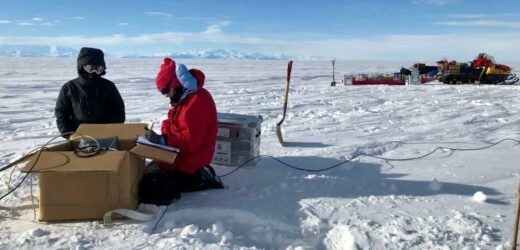Antarctica: Scientists set up station on the Whillans Ice Stream
We use your sign-up to provide content in ways you’ve consented to and to improve our understanding of you. This may include adverts from us and 3rd parties based on our understanding. You can unsubscribe at any time. More info
Ice streams — a type of glacier — are fast-moving regions within ice sheets that can travel, under their own weight, up to some 3,300 feet each year. As geophysicist Chloe Gustafson of the Scripps Institute of Oceanography in California explains, “ice streams are important because they funnel about 90 percent of Antarctica’s ice from the interior out to the margins.” It has long been suspected that groundwater may lie at the base of these streams and serve to affect how the ice streams flow, but their presence had never been confirmed until now.
According to Dr Gustafson and her colleagues, were it possible to squeeze the groundwater that they detected from the sediments beneath the ice up onto the surface, it would form a lake some 722–2,690 feet deep.
Dr Gustafson added: “The Empire State Building up to the antenna is about 420 metres tall.”
“At the shallow end, our water would go up the Empire State Building about halfway. At the deepest end, it’s almost two Empire State Buildings stacked on top of each other.
“This is significant because subglacial lakes in this area are two to 15 metres deep. That’s like one to four stories of the Empire State Building.”


In their study, the researchers used a geophysical surveying method known as magnetotellurics to measure Antarctic groundwater beneath the Whillans Ice Stream between 2018 and 2019.
This established technique uses natural variations in the Earth’s electric and magnetic fields to measure the electrical resistivity of the subsurface — but this is the first time that such has been applied to look for the presence of groundwater beneath a glacial ice stream.
Previously, magnetotellurics had only been used to image deep crustal features at depths in excess of 6.2 miles — rather than hydrological features closer to the surface.
The approach allowed the team to see deeper than airborne electromagnetic surveys, which can only see down through about 1,148 feet of ice — much less than the depth of the Whillans Ice Stream, which is 2,625 feet thick in parts.


Paper author and earth scientist Professor Kerry Key of New York’s Columbia University said: “We imaged from the ice bed to about five kilometres [3.1 miles] and even deeper.”
Glaciologist Professor Helen Amanda Fricker of the Scripps Polar Center added: “This is a nice demonstration of the power of the technique and how much it can bring to our knowledge of not just Antarctica, but Greenland and other glacier regions, as well.”
Alongside the electromagnetic measurements, the team also probed the subsurface using seismic imaging.
This data confirmed that thick sediments were buried under the ice and snow throughout the area — some 60 miles wide — that separated the two magnetotelluric survey sites.
DON’T MISS:
Shark mystery as super-rare ‘living fossil’ with 300 teeth found [REPORT]
Russia’s ‘only oil pipeline to EU’ in flames – 3 countries face crisis [INSIGHT]
How the UK, US and their allies could respond to a nuclear attack [ANALYSIS]

Although the researchers only imaged one of Antarctica’s ice streams, there are many more within the continent’s ice sheets, they noted.
The findings, Dr Gustafson added, “suggests that there is probably groundwater beneath more Antarctic ice streams.”
According to the researchers, the existence of groundwater under the ice sheets of Antarctica has implications for climate change.
Carbon, previously stored by seawater-adapted communities of microbes, could be released from these water systems in significant quantities.
Dr Gustafson said: “Groundwater movement means there’s potential for more carbon being transported to the ocean than what we’ve previously considered.”
It is also possible that groundwater reserves may also exist under similar conditions on other planets or moons that are releasing heat from their interior.
Professor Key said: “You can imagine a frozen lid over a liquid interior, whether it’s completely liquid, or liquid-saturated sediments.
“You can think of what we see in Antarctica as potentially analogous to what you might find on Europa or some other ice-covered planets or moons.”
The full findings of the study were published in the journal Science.
Source: Read Full Article


